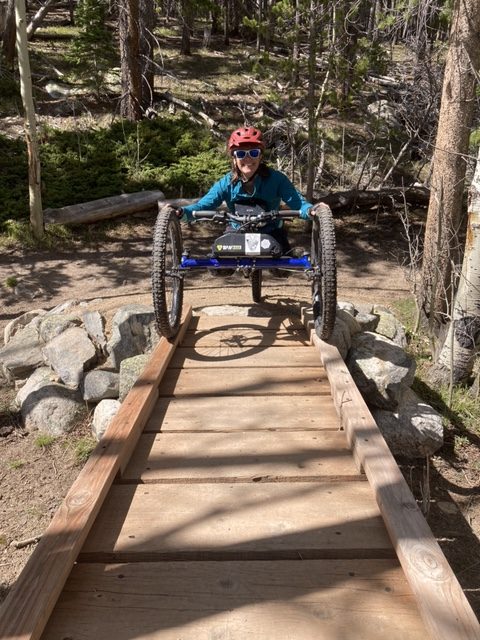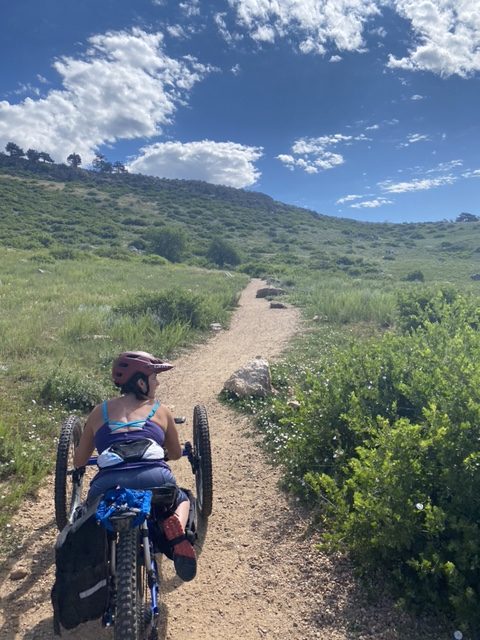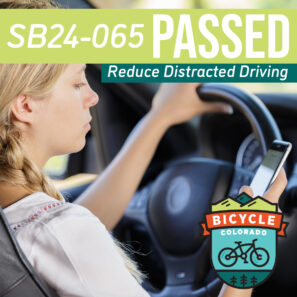What’s the deal with adaptive eBikes?
Quinn Brett is a Program Analyst with the Wilderness, Outdoor Recreation and Accessibility divisions in the National Park Service (NPS). She is also a bicyclist with a disability. A former Climbing Ranger in Rocky Mountain National Park (RNMP), Quinn took a climbing fall in 2017 and is now paralyzed from the waist down.
We spoke with her about her work with the NPS, why and how she bikes now, and her thoughts on e-assist devices on trails.

What does your work look like day to day?
I’ve only been back in this role for 3 or 4 months. My duties vary but match my skill-set and experiences. I am helping build both the public facing websites for wilderness accessibility and outdoor recreation accessibility, as well as internal informational sites within the NPS.
I also work on partnerships to improve wilderness recreational experiences for persons with a disability. For example, I am waiting on a grant written by Beneficial Designs. If we are awarded the grant, Beneficial Designs would work with 4-5 different National Parks to gather GIS data on 2-3 wilderness trails in those parks. This would serve as a pilot program to map those trails, what the terrain is like specifically, and to create more objective sign data and mapping data for all trail users. Much of the trail information in National Parks is outdated, due to back-log of funding and catching up to increased standards over years. Older trail information state something similar to, “This trail is easy/moderate/difficult.” New objective data includes describing slope grade overall, like the maximum and minimum rise, and similar descriptions of cross slope, major obstacles or pinch points, trail surface and step heights. That way all users, disabled, older, with children, large groups, can make a more informed decision if that trail would work for them.
Why do you bike?
I hand-cycle now because it’s a way for me to traverse the earth like I used to on my feet.
What kinds of activities do you do on trails and what are the equipment that you use for each activity?
On trails I have a variety of devices; two different off-road mobility devices and a Nordic sit ski. The Nordic ski is a bucket seat with two skinny skis attached underneath, the same width as a Nordic ski track. I push myself with ski poles. It is lovely to get outside in the winter, get some cardio and be with friends. The trails locally that I have been exploring include Trail Ridge Road and Wild Basin area trails in Rocky Mountain National Park.
For summertime, I use either of my two different battery equipped trikes. Incredible machines for both my physical and mental health. One is hand propelled with an e-assist that works with my arm cadence, the Reactive Adaptations Bomber. The other one, the Bowhead Reach, is solely battery powered. They are unique and excel on different terrain for different reasons. The Bowhead has a narrower width and excellent side to side articulation, which opens up tighter trails or trails that might cut a hillside. The Reactive has a lovely amount of space in its underbelly, meaning good clearance for the rocky mountain trails that I am trying to navigate.
In what ways are your adaptive bikes different from two-wheeled bikes and in what ways are they similar?
The biggest difference is that most adaptive equipment is three- or four-wheeled. There are some people out there who have adapted a two-wheeled bicycle with a bucket seat instead of the bike seat, taping their feet to the pedals and a few other modifications. These require a motor and friends to help load/unload etc. Folks are inventing cool, unique stuff but it is all very small-time and expensive.

You mentioned your climbing accident before. Are you comfortable telling us a little bit more about that? What were your thoughts when you realized what happened?
From a woman whose family was like, “You can’t sit still!” and now being in a wheelchair, sitting, I still can’t sit still. Healing has definitely been a very challenging process. I was a professional athlete, an incredible mover. That’s how I expressed my being, by dancing or running around or just twirling every minute of every day. The healing process ebbs and flows, and there is more space between the tears.
I went on this road trip a year after my injury and I was feeling so psyched! I was on the road by myself for two months, feeling independent and like a small morsel of my old self. One day randomly on the road trip, I found myself overwhelmed with sadness and tears like the early days of my injury. I was like, “I’m back here again? I thought I was over that!”
I have realized that my grief will always be here. Sometimes you get away from it or distract and sometimes you sit down right in its lap.
What was the recovery process like?
I joke with my climbing friends that this is my longest rest day. This injury has so many non-visual and life altering accomplices aside from just lack of muscle movement. My bladder and bowels don’t work the same, I have no sensation to touch, hot or cold or pain below the level of my injury. The daily and persistent nerve pain is an unexpected and mood spoiling side effect of spinal cord injury. I’m lucky, in comparison to some, as I have hand function, no brain injury and pretty good ab control. I also have that athletic, problem-solving background. By month three I was swimming and I tried my first hand-cycle. I got my own Reactive Adaptions Bomber, without a battery at first, about nine months after my injury. I feel like I am in decent shape now, though lacking the giant lungs I was so proud of before, as getting my heart rate up for long periods of times with just my arms is difficult.
Speaking of getting that bike, what made you decide to get back into bicycling after the accident?
Well I was still in the hospital and had a good climbing adventure buddy who is also a big biker order the Reactive for me. He ordered it in February or March or something and I was like, “Woohoo, a brand new bike! Just in time for summertime!” By August I was emailing the company like, “Where is my bike?! Summer is almost over! I need to get outside!”
When I first got it, I did not get the battery. It was totally disheartening to be on trails that I used to run in 20 minutes before but now with just my arms it would take an hour. I also had to learn how to use the machine. I really didn’t love it at first actually. I was sad to be on trails that were so familiar and easy and now so difficult and inaccessible. I missed challenging myself and my friends and working together at a similar pace.
The following spring, I caved and ordered the battery. With the battery, I was like, “Oh, this machine is rad.” I can go places and I can cover ground! I did the White Rim trail, which is 100 miles, in three days. Last week, I got back from The San Rafael Swell, where I did another three-day bike-packing trip.
I wish for more people with disabilities to know about these machines, have better access to them and more awareness of trails that are doable.
For you, what is the difference between an e-trike and a motorized wheelchair?
Because I have fully functioning arms, I use a manual wheelchair. A power wheelchair weighs generally 350-400 pounds, and they’re just not made for off-pavement terrain. Packed gravel is sometimes okay, but that is the extent of the typical power chair ability. Whereas these hand cycles, with or without battery, have the mechanical advantage of 3-4 sturdy wheels and are way lighter. Meaning, they are made to be more maneuverable on a variety of terrain.
Yes, they look like bikes, they have wheels and cranks and chains and all of that stuff. As a person with a disability using a device made specifically for my disability, it is more so my off-road mobility device. I can bike with it but I can also hike with it and the battery either way helps me actually cover more than a paved mile trail.
I’ve been working with Joe Stone from Teton Adaptive Sports, trying to come up ways to better communicate best practices within our community. For example, how somebody on foot trammels across the tundra where it says “Please don’t cross here, restoration area,” adaptive hikers could also dismiss signs that suggests closures. Joe has been making some great videos reminding adaptive users to pace your battery-assisted device to the pace of trail traffic around you. Go hiking pace, if you’re hiking.
Video: Quinn rides her electric-assist trike on a mountain bike trail.
Some mountain bike advocates take issue with eBikes and motorized wheelchairs on trails. Why do you think that’s a limited perspective?
I have had some great conversations with folks in the bike industry, like Richard [Edwards] of IMBA. He told me, “We’re getting a lot of pushback from the biking community about how we’ve been specifically developing beginner/adaptive bike trails with intent.” Some in the bike community are upset about this consideration and that is unfortunate. Before my injury I probably would have been stingy against eBikes too. I have had a forced broadening of perspective. Without the battery I wouldn’t be getting outside, I wouldn’t be playing alongside my friends, I wouldn’t feel as much joy or feel like I am taking care of my body. As someone with a disability, our mobility devices are exempt from new eBike policies, as the policies pertain to two-wheeled bikes.
I feel like there is that stigma to the two-wheeled riders using a battery. People say, “Why do they need it? Just try harder,” or, “They are going to rip around, cause more erosion, be more reckless,” those kind of narratives.
I have a spinal cord injury that is pretty obvious that my legs don’t work. If I was injured one vertebra lower I would have the use of just my quadriceps, no hamstrings, glutes, but that ability of your quads means I could push and stand up and lock my knees out. There are some in the community who have that ability, minor leg function, who want to ride their two-wheeled bike. That’s really difficult to do if you only have two leg muscles working so an eBike makes that a possibility. Yes, like mentioned above, there are jerks out there, but putting a battery on your bike does not make you an immediate jerk. The majority of people using an eBike just have a similar desire, as I did, to find a way to continue exploring nature and recreate with our friends, as our bodies change.
Some concerns about eBikes on trails center around erosion and land damage. What do you make of those concerns?
A lot of the trails for hiking and biking are multiple-use. A variety of users’ habits, amount of traffic and natural elements can all cause erosion. I think that just speaks to better, more sustainable trail building techniques. What we need as adaptive hand cyclists doesn’t necessarily mean a paved trail, a super wide trail or a super manicured trail. We can all benefit from a trail that is more sustainably built, for the cross-slope, the erosion, the steps that keep getting bigger or bigger because people have stepped off of them or the water has run through them, or horses. When a trail is narrow, people want to pass you, they’re stepping off.

Have you ever had a negative interaction with another person while on the trails riding in your adaptive bike, and how do you respond?
I’ve had a few, and mostly a comment of, “No bikes are allowed here,” or, “No eBikes allowed here.” Most times it is due to lack of awareness. Again, it looks like a bike that I am pedaling with my arms, folks just don’t realize that arm day is every day.
Does your perspective of being lower to the ground affect your experience on the trail?
Totally! My face is closer to the horse poop and all of that.
What, to you, would be reasonable rules governing e-equipment on trails that are inclusive and accessible?
I’m broadening my horizons. I think that they should be acceptable and we should just make messaging at the trailhead instead of trying to micromanage everyone’s behavior … Have community advocates who are like, “Use this in the same demeanor as everyone else on the trail.” If you have an eBike, it’s getting a lot more people out there recreating and smiling. So why restrict?
Because there are different classes of eBikes, would it be reasonable to distinguish based on those?
I think that’s totally reasonable. And labeling which ones are allowed of the three classes at the trailhead.
Any other final thoughts?
I was injured in 2017 and eBikes had been on the scene for a while, but the recent policies are bringing them to the forefront. National Parks has just allowed them on any trail where regular bikes are allowed. I think we are going to be seeing a lot more of them, and I think it’s an okay thing. Change is okay.

We are grateful to Quality Bicycle Products for their support of our diversity, equity and inclusion work. They makes stories like this possible.
Become an individual Member or a Business Member of Bicycle Colorado today!
Leave A COMMENT
Our twitter feed is unavailable right now.
The Latest News
view all- Jul 1, 2025
- by Bicycle Colorado
In Their Words: Siblings Log Thousands of Miles by Biking to School
Guest Blog Post: By The Williams Family It sounds like a scene from a bygone era: a brother and sister set off on bicycles to school each and every morning, sometimes stopping at the public library or the ice cream parlor on the way home after school. For Denver residents Luella and…
- Bicycle Commuting,
- Kids on Bikes,
- Safe Routes,
- Transportation Talk
- No Comments









COMMENTS (4)
Mary Makuc -
Excellent article! Thanks for “paving the way for others”Incomplete para here for 37 years. Would like to go on trails with my family. They hike regularly. Ian looking for an e tricycle since I do have control of one leg all the way and extensors on the other. Can’t do two wheel . Not great balance or arm strength.Vendors?
Aishwarya Krishnamoorthy -
Hi Mary! Thank you for reading! We don’t currently have a list of bicycle or tricycle vendors, but we are in the process of creating a webpage for adaptive cycling that we hope will provide some resources like that. In the meantime, some of our friends have recommended Hase brand adaptive cycles and offerings from All Ability Cycles in Iowa, who sell Hase and Van Raam products. You can find contact information and posts about adaptive cycling on their Facebook page at https://www.facebook.com/AllAbilityCycles/.
Jason Hall -
Hi there, i am a high level quadriplegic with no movement from the shoulders down and am looking for an adaptive cycle that can be operated with shoulder and head movement. Is there anything out there which would allow someone like me to get out with my MTB buddies and enjoy riding again?
Aishwarya Krishnamoorthy -
Hi Jason, thanks for your question. You might try to reach out to one of the retailers of adaptive bikes listed on our Adaptive Riding in Colorado page: https://www.bicyclecolorado.org/adaptive/
They might have ideas for the kind of modifications you’d need!